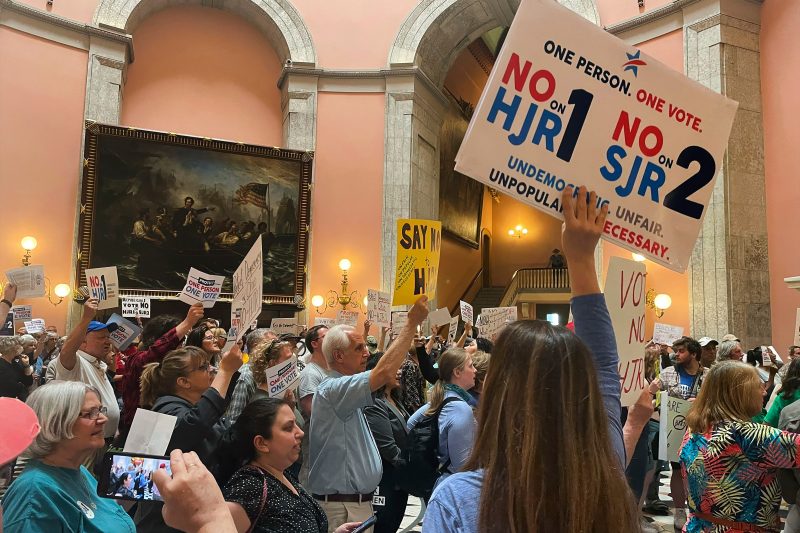On Tuesday, Ohio voters will participate in a special election to decide “State Issue 1,” a ballot measure that has galvanized supporters and critics alike, especially because it could affect another upcoming vote on whether to enshrine abortion rights into the state constitution. Here’s a look at what Issue 1 would do, and its potential effect on abortion in Ohio.
Issue 1 is a ballot measure that seeks to make it more difficult to amend the state’s constitution through — yes — future ballot initiatives.
Currently, a ballot initiative in Ohio needs a simple majority to pass. If Issue 1 passes, that threshold would be raised to 60 percent of the vote.
The proposal also would impose more stringent requirements on how signatures are gathered for ballot initiative campaigns. Campaigns must gather enough signatures to equal 5 percent of the votes cast for governor from 44 of the 88 counties in Ohio. Issue 1’s passing would mean campaigns would have to gather that same percentage of signatures from all 88 counties to get a citizen-led initiative on the ballot.
Voting “Yes” on Issue 1 means you support making it more difficult to amend Ohio’s constitution through ballot initiatives, principally by raising the threshold for a ballot measure to pass from a simple majority to 60 percent of the vote.
Voting “No” on Issue 1 means you support the status quo, in which a ballot initiative can pass with a simple majority of the vote.
If Issue 1 passes, it would take effect immediately, meaning future ballot initiatives in Ohio — including the one on abortion this fall — would require 60 percent of the vote to pass, rather than just a simple majority.
In recent weeks, a ballot measure that would codify abortion rights into Ohio’s state constitution was certified to appear on the November general election ballot. If Issue 1 passes on Tuesday, that would make it more difficult for the abortion rights ballot measure to pass in November.
Ohio is among several states where lawmakers have sought to make it more difficult to pass citizen-led initiatives after liberal policies — from protecting abortion rights to expanding Medicaid to raising the minimum wage — won at the ballot box. Efforts to raise the bar to amend state constitutions have cropped up during legislative sessions in recent years.
If such efforts prevail, they could throw a wrench into one of abortion rights groups’ key strategies for restoring access to the procedure in states where it is banned. Since Roe v. Wade was overturned, advocates have been exploring ballot measures to enshrine the procedure’s legality into state constitutions in at least a dozen states.
Ohio Republican lawmakers, who overwhelmingly support Issue 1, have insisted it is not related to abortion. But in June, Ohio Secretary of State Frank LaRose (R), who is running for U.S. Senate, told GOP supporters that Issue 1 “is 100 percent about keeping a radical, pro-abortion amendment out of our constitution.” Proponents of Issue 1 have also used antiabortion messaging and imagery to campaign for the ballot measure.
Ohio Republicans, who hold a supermajority in the state legislature, said Issue 1 is meant to protect the state constitution from special-interest groups.
“By raising the threshold for constitutional amendments to 60 percent, the People will ensure amendments have widespread support and tell special interests that our Constitution is not up for grabs,” state Rep. Brian Stewart and state Sen. Rob McColley wrote in a joint argument for Issue 1.
They also cast the new signature-gathering requirements as a way to ensure that “a diverse and representative population of Ohioans will determine whether proposed amendments appear on the ballot.”
Though many Republicans have denied that Issue 1 is directly related to preventing a future abortion rights ballot measure from passing, Ohio’s secretary of state has been open about the connection between the ballot initiatives. This week, LaRose further injected politics into the matter by challenging his Republican primary opponents in the Senate race to donate $1 million each “to help fund the closing days of the campaign for State Issue 1.”
Democrats have argued that Issue 1 is an attempt by Republicans to quash voter efforts to enshrine abortion rights into state law after the U.S. Supreme Court overturned Roe v. Wade.
The nonpartisan coalition One Person One Vote, which has been campaigning to reject the ballot measure, has called Issue 1 “misleading,” and accused its backers of trying to ram the issue through in an August special election during an off year, when fewer voters turn out.
“Ohioans must know: Issue 1 was designed to trick voters into giving away their rights — and the special interests who bought the August 8 special election will stop at nothing to end 100 years of majority rule in Ohio,” the group said in a statement in June.
Ohio Democrats, who oppose the ballot measure, have warned that if Issue 1 passes, it would undo constitutional protections that have been in place since 1912.
“If this amendment passes, it will apply to every single amendment on any issue Ohioans will ever vote on — you name it, just 40 percent of voters will decide,” a group of Democratic state lawmakers wrote in an argument against Issue 1. “We all deserve to make decisions that impact our lives. We must protect our freedom to determine our future, not permanently change our constitution to give up our rights.”
In May, One Person One Vote filed a lawsuit arguing that the ballot language was misleading. The group complained that the ballot language did not state what the law currently is; that it did not include the full text of the proposed amendment on the ballot; that it did not accurately describe the new number of elector signatures that would be required from each county; and that the title of the ballot — “Elevating the standards to qualify for and to pass any constitutional amendment” — suggested incorrectly that the amendment would make it more difficult to pass all proposed constitutional amendments, not just ballot initiatives.
In a June ruling, the Ohio Supreme Court agreed with One Person One Vote on several points, ordering the Ohio Ballot Board to correct the language describing the proposed changes to the signature-gathering process and to rename the ballot title without using the word “any” in reference to “constitutional amendment.”
However, the court rejected the group’s complaint that the word “elevating” in the title suggested the existing requirements were too low. The court also rejected the arguments that the ballot measure in August needed to state what the law currently is and include the full text of the proposed amendment. The three Democratic justices on the court dissented, saying they would have required more of the ballot language to be rewritten.
The Republican-majority Ballot Board approved rewritten ballot language for Issue 1 shortly after the ruling.
Rachel Roubein contributed to this report.

































